高中英语必修四unit4公开课课件
- 格式:ppt
- 大小:4.84 MB
- 文档页数:32
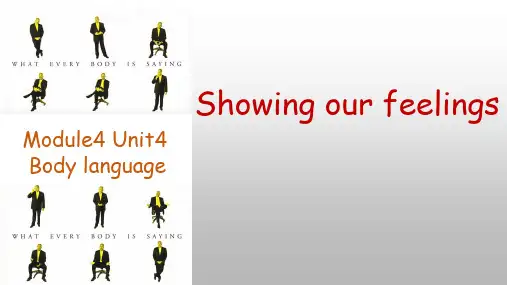
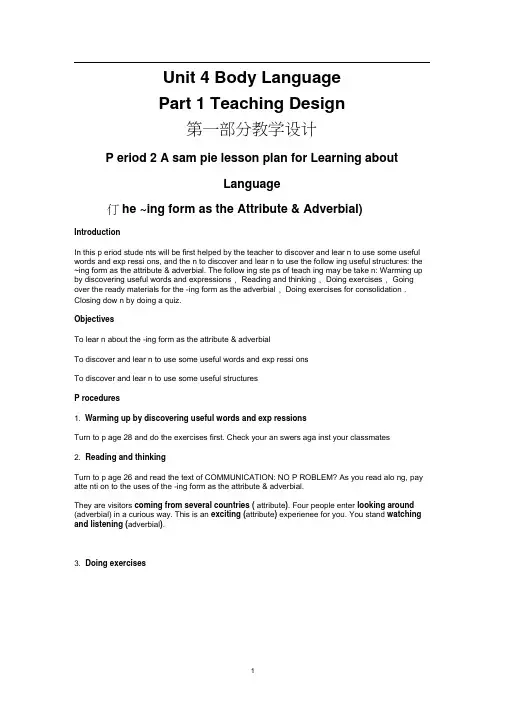
Unit 4 Body LanguagePart 1 Teaching Design第一部分教学设计P eriod 2 A sam pie lesson plan for Learning aboutLanguage仃he ~ing form as the Attribute & Adverbial)IntroductionIn this p eriod stude nts will be first helped by the teacher to discover and lear n to use some useful words and exp ressi ons, and the n to discover and lear n to use the follow ing useful structures: the ~ing form as the attribute & adverbial. The follow ing ste ps of teach ing may be take n: Warming up by discovering useful words and expressions , Reading and thinking , Doing exercises , Going over the ready materials for the -ing form as the adverbial , Doing exercises for consolidation , Closing dow n by doing a quiz.ObjectivesTo lear n about the -ing form as the attribute & adverbialTo discover and lear n to use some useful words and exp ressi onsTo discover and lear n to use some useful structuresP rocedures1. Warming up by discovering useful words and exp ressionsTurn to p age 28 and do the exercises first. Check your an swers aga inst your classmates2. Reading and thinkingTurn to p age 26 and read the text of COMMUNICATION: NO P ROBLEM? As you read alo ng, pay atte nti on to the uses of the -ing form as the attribute & adverbial.They are visitors coming from several countries ( attribute). Four people enter looking around (adverbial) in a curious way. This is an exciting (attribute) experienee for you. You stand watching and listening (adverbial).3. Doing exercisesTurn to p age 29. Do the exercises.4. Studying the ~ing form as the adverbialthe -ng form as the adverbialthe -ing form 作状语表示主语在进行一动作的同时所进行的另一动作,它对谓语动词起修饰 或陪衬的作用。
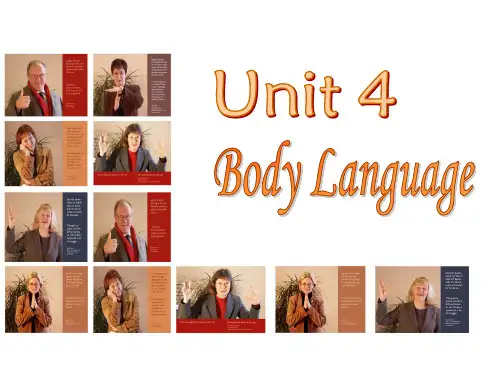
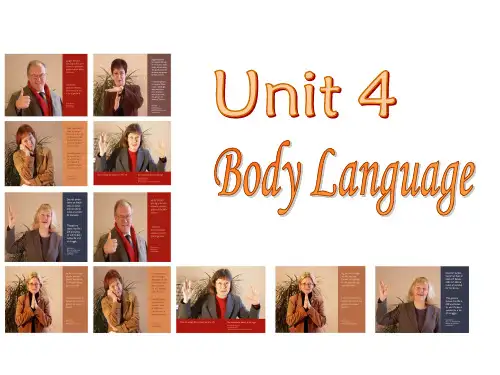
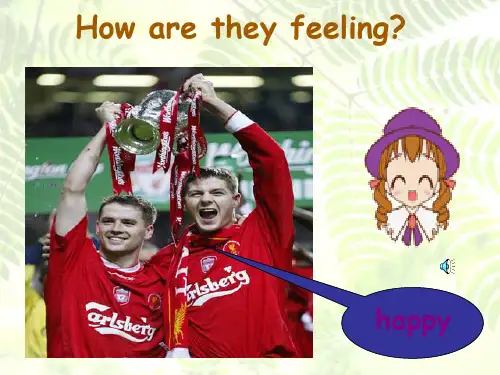
![高中英语人教必修四 Unit4 Communication no problem阅读[课件] (共14张PPT)](https://uimg.taocdn.com/ed68322f02768e9951e738c4.webp)

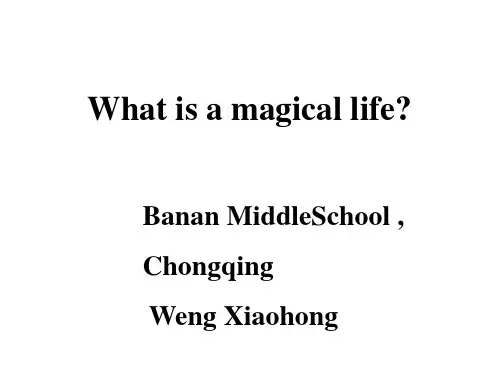

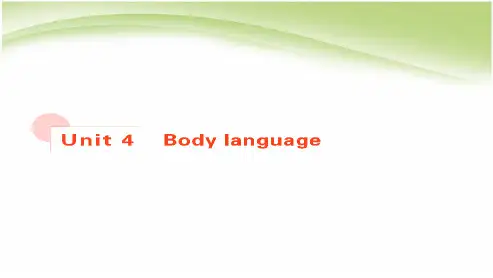

Unit 4 Body language •What do you think the purpose of language?•How can you communicate with someone if you cannot speak?•How many ways can you think of to greet someone if you cannot speak?Communication: No problem?•Step1. fast reading•1) What is the main idea of the text?2) How many parts can we divide the passageinto?3) What’s the main idea for each part?•1) What is the main idea of the text?–The passage introduces some examples of cultural body language when greetingpeople.•2) How many parts can we divide the •passage into?–Part 1 (para. 1)–Part 2 (para. 2 and 3 )–Part 3 (para. 4 and 5 )3) What’s the main idea for each part?Part 1 (para. 1)We are sent to Capital International Airport to meet some international students.Part 2 (para. 2 and 3)Examples of learned or cultural “bodylanguage”.Part 3 (para. 4 and 5)Different people have different physical ways to greet others. Learning about their customs can help avoid difficulties in communication.Step 2. Scan the text and find outCountry / Area Ways to greet each otherBritain Shake hands. Do not stand very close to others or touchstrangers when they meet.Canada Shake hands.Japan Bow.Spain, Italy, SouthAmerican countriesApproach others closely and are more likely to touch them. France Shake hands and kiss each other twice on each cheek.Middle East, some Muslim countries Shake hands and stand quite close to other men. Nod to women but do not shake hands with them.Name Description Body language To whom Tony Garcia man from Colombia Kiss on the cheek everyoneJulia Smith woman from Britain no touching everyoneAkira Nagata man from Japan bowing everyone George Cook man from Canada shaking hands everyoneAhmed Aziz man from Jordan shaking handsnodding to manto womanDarlene Coulon woman from France shake hands and kisstwice on each cheekpeople she knowsStep 3. use the passage to help you answer the following questions1) Is the author of this passage male or female? How doyou know?The author is male. Ahmed Aziz will not shake hands with women, but he shakes hands with the author.2) What were the two mistakes that the author noticed?He noticed that the Colombian man kissed theBritish woman, but in her culture, a kiss from astranger is not expected. He also noticed that theJapanese man bowed just as the Canadian manstarted to shake hands, so one man’s nosetouched the other man’s hand.•3)Who seemed to prefer to keep more physical diastance from others? Who seemed to prefer closer physical distance ?•The British woman, Julia and probably the Canadian man, George, seemed to prefer to keep more physicaldistance from others. The Colombian man, Tony, and the Jordanian man Ahmed, seemed to prefer closer physical distance.•4) Did any students have similar greeting customs? If so, which one?•Yes. Tony from Colombia and Darlene from France had a similar greeting custom —a kiss. George from Canada and Ahmed from Jordan also had a similar greeting custom —a handshake, but Ahmed shakes hands only with men.•5) “When in Rome, do as the Romans do.”What do you think this famous saying means?•This saying means that when we are in a certain place, we should follow the customs of the people who live in that place, not our own customs.•6) Do you agree with the author’s statement that body language is not good or bad? Why or why not?Step 4. summaryStep 5. translation1.The first person to arrive was TonyGarcia, closely followed by Julia Smith from Britain.2. Not all cultures greet each other thesame way, nor are they comfortable in the same way with touching or distance between people.3. However, people from places like Spain,Italy or South American countriesapproach others closely and are morelikely to touch them.Step 5. homework •Complete p.27 Exercise 3。
Unit 4 Body LanguagePart 1 Teaching Design第一部分教学设计P eriod 2 A sam pie lesson plan for Learning aboutLanguage仃he ~ing form as the Attribute & Adverbial)Introductio nIn this p eriod stude nts will be first helped by the teacher to discover and lear n to use some useful words and exp ressi ons, and the n to discover and lear n to use the follow ing useful structures: the ~ing form as the attribute & adverbial. The follow ing ste ps of teach ing may be take n: Warming up by discoveri ng useful words and expressi ons , Reading and thin king , Doing exercises , Going over the ready materials for the ・ing form as the adverbial , Doing exercises for consolidation , Closing dow n by doing a quiz.ObjectivesTo lear n about the -ing form as the attribute & adverbialTo discover and lear n to use some useful words and exp ressi onsTo discover and lear n to use some useful structuresP rocedures1. Warming up by discovering useful words and exp ressionsTurn to p age 28 and do the exercises first. Check your an swers aga inst your classmates2. Reading and thinkingTurn to p age 26 and read the text of COMMUNICATION: NO P ROBLEM? As you read alo ng, pay atte nti on to the uses of the -ing form as the attribute & adverbial.They are visitors comi ng from several coun tries ( attribute). Four people enter looking around (adverbial) in a curious way. This is an exciting (attribute) experienee for you. You stand watching and listening (adverbial).3. Doing exercisesTurn to p age 29. Do the exercises.4. Studying the -ing form as the adverbialthe ・ng form as the adverbialthe -ing form作状语表示主语在进行一动作的同时所进行的另一动作,它对谓语动词起修饰或陪衬的作用。